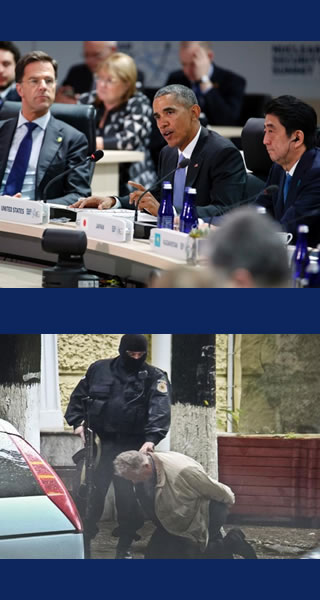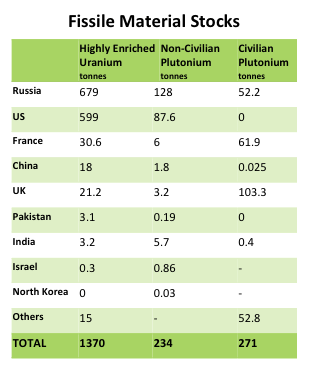Life After the Nuclear Security Summits: Are We Safe?
Life After the Nuclear Security Summits: Are We Safe?

WASHINGTON: Just before President Barack Obama hosted the last biennial Nuclear Security Summit of his presidency, Belgian authorities reported chilling evidence. Affiliates of the terrorists who attacked the Brussels airport and subway system had also installed a surveillance camera outside the house of a senior nuclear worker. This incident follows other instances of sabotage and extremism within the country’s nuclear industry, raising fears that terrorists want to cause a major nuclear accident or seize nuclear material that could perhaps be turned into a "dirty bomb."
The nuclear summits, among Obama’s most successful national security innovations, have made considerable progress in raising awareness about this post–Cold War danger and securing measures to avert it, but the discovery in Brussels serves as a reminder how serious the global threat remains.
Since the end of the Cold War, a variety of terrorist groups have tried to obtain weapons of mass destruction, and the threat has increased in recent years. The so-called Islamic State and other contemporary terrorists have employed chemical weapons in several countries and seek even more powerful nuclear weapons.
The summits have reinforced a critical obstacle to this threat. The main impediment to nuclear terrorism is not organizing an attack, designing a weapon or recruiting volunteers willing to suffer martyrdom – it is obtaining the nuclear or radiological material needed to make an explosive device.
The global stock of fissile material is enormous, and it only takes the diversion of a small amount of this material to wreak havoc. The world has almost 2,000 metric tons of highly enriched uranium, HEU, and separated plutonium. These fissile materials could be used to manufacture approximately 100,000 nuclear bombs.
By the end of 2014, the International Atomic Energy Agency, IAEA, had confirmed more than 2,700 incidents of illegal trafficking in nuclear and other radioactive material.
The early summits concentrated on securing the “direct use” fissile materials, HEU and separated plutonium, which terrorists or rogue states could employ to make nuclear weapons. More recently, the meetings have also addressed the risks that terrorists might obtain more widely available radiological sources, such as cobalt-60 and caesium-137, and combine them with conventional explosives in a dirty bomb. Although such a hybrid device would not kill as many people as a nuclear weapon, it could cause widespread havoc and impose severe economic costs by disrupting a major port or city. Recent summits also addressed terrorist attacks on nuclear power plants, either directly, or with cyber means.
In each of the four summits, participating governments made nonbinding commitments to augment their nuclear security regulations and legislation, including measures to prevent nuclear and radiological trafficking; reduce use of fissile materials; elevate training of nuclear security personnel; and join international treaties and conventions on nuclear security.

Progress is evident. The summits have seen more states participating and more voluntary contributions by individual countries and groups of states to enhance nuclear security. In addition, they have been augmented by related industry and NGO expert meetings, held at the time of the summits.
Since the summits began in April 2010, more than a dozen states, and the entire South American continent, have eliminated or removed all their weapons-usable material, almost four tons worth. Hundreds of radiation detectors and other impediments to nuclear smuggling have been deployed. Furthermore, many inherently vulnerable research reactors have switched from using HEU fuel to employing low-enriched uranium, LEU. More than a dozen training centers of nuclear security excellence have been built including those in Lithuania, Pakistan and mostly recently in China.
This last summit focused on building a strong post-summit nuclear security architecture based on other institutions and initiatives. Most notably, the summit issued action plans for the nuclear security agendas of the United Nations, the IAEA, and other institutions. The summit also secured sufficient backing to secure ratification of an amendment to strengthen the hitherto weak Convention on the Physical Protection of Nuclear Material, making the agreement the de facto legal standard for securing nuclear materials.
The summit attendees have pledged to hold regular high-level ministerial meetings on the issue. Indeed, they have invited countries that have not participated in the summits to join this new “Nuclear Security Contact Group,” which would make the process more inclusive.
However, doubt lingers whether nuclear security will see sustainable progress without the high-profile leadership and attention that the four heads-of-state summits provided. Furthermore, Russian opposition to the summits could weaken sustainable progress in countering nuclear terrorism.
Unlike in the past, when Russia and the United States cooperated on nuclear questions even while disputing other issues, recent tensions have disrupted progress on nonproliferation and arms control – with Russian President Vladimir Putin boycotting the most recent summit.
For a while, Russia and the West cooperated on Iran, North Korea and other nonproliferation challenges. The previous summit in The Hague occurred just after Moscow’s March 2014 annexation of the Crimean Peninsula, and the Russian delegation, led by Foreign Minister Sergey Lavrov, played an active part in the deliberations. But since the July 2015 nuclear agreement with Iran, Russian-US differences have grown to match those in traditional arms control, terrorism and regional security.
Although the Russian government has raised substantive objections to continuing the summits, such as Moscow’s sense that the US and its allies were unduly limiting Russia’s role and that the summits had outlived their usefulness, the Russians likely boycotted the last summit to also retaliate against Obama’s harder line against them, similar to how they have banned the import of some EU goods in response to European sanctions against Russia.
With Russian-US cooperation on nuclear security constrained, China may have a pivotal role in driving progress in this area. A reluctant participant in early summits, China has become more enthusiastic about international cooperation on nuclear security following the expansion of the terrorist threat inside China, the country’s growing use of nuclear energy and ambitions to export more nuclear services, and China’s enormous stake in safe and security international commerce. Chinese policymakers now recognize that nuclear security offers opportunities for “win-win” solutions since everyone would suffer from a major nuclear terrorist incident anywhere
In addition to enhancing its own security and securing points with the United States, Beijing has been able to be a regime-maker rather than a regime-taker in the nuclear security domain, unlike what has happened often in past, such as with the World Bank and International Monetary Fund, when China had to accept the existing rules of the game to become a major player. In the relatively recent field of countering nuclear terrorism, China has been an equal founding partner in building the emerging system of rules and procedures.
With China’s help, nuclear security cooperation could remain a global priority; otherwise, it may take a horrific and avoidable nuclear terrorist incident to reboot the process.
Dr. Richard Weitz is a senior fellow and director of the Hudson Institute Center for Political-Military Relations. He would like thank the John D. and Catherine T. MacArthur Foundation for supporting his research and writing on non-proliferation issues.